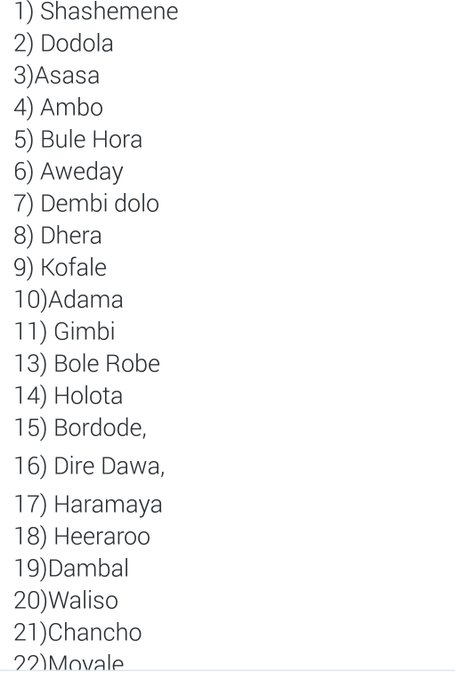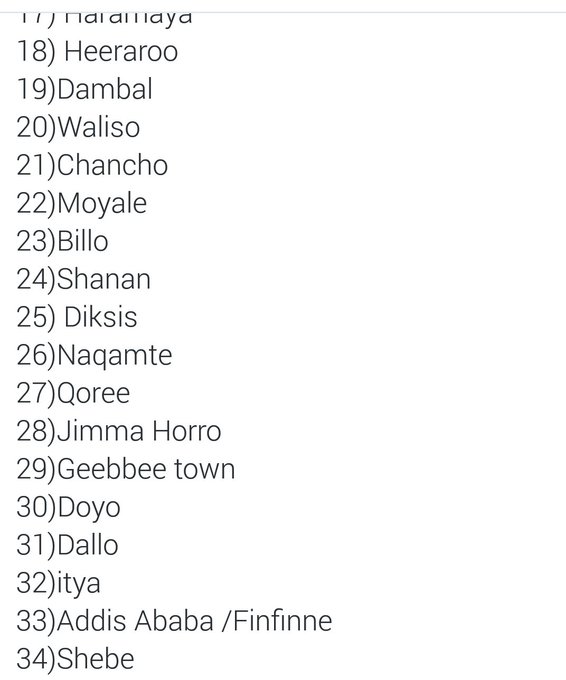LIVE blog: Dozens feared dead as #OromoProtests sweep Oromia
(OPride) — A planned protest in Ethiopia’s Oromia state has turned deadly. Scores have been killed after federal police and security forces opened fire on peaceful protesters , according to eyewitness and reports on social media. Hundreds of thousands took to the streets in more than 50 towns across Oromia early Saturday morning in what has been billed as a ‘national day of rage’ to protest the Oromo people’s continued marginalization and targeted human rights abuses in Ethiopia. The situation in the populous state, home to the Oromo people, remains tense and volatile. In the last two days, embassies of the United States, Norway and the United Nations office in Ethiopia have all issued travel warnings for the weekend.
Activists say at least 50 people have been killed and protests took place in some 200 towns across Oromia. OPride is only able confirm protests in about 51 towns so far.
#OromoProtests:+200 cities rejected Eprdf rule.Due to the blockage of social media only 34 places are covered on SM
.@reuters on #OromoProtests: #Ethiopia's security forces use tear gas to disperse protests - witness reut.rs/2aCIkK9 via@Reuters
Context and analysis from Hassen Hussein in MinnesotaToday’s Oromia-wide protests took place in the backdrop of threats and stern warnings by the regional president, Muktar Kadir, and the Prime Minister, Hailemariam Desalegn.
Muktar Kadir:
- Saturday’s protests are neither legal nor peaceful
- Not called by a local entity with a legal standing
- Past protests simply destroyed infrastructure
- People should stay away from the streets
Hailemariam Desalegn:
- Anti-development and anti-peace elements trying to turn us into Somalia
- The underlying core of the protests is narrow nationalism and chauvinism. In EPRDF’s convoluted language, the former referred to the Oromo, the country’s largest population, and the latter the Amhara, the country’s second largest population. The two groups together make up about two-thirds of the country’s population of close to 100 million. With vast sections of the populace openly rejecting the authority of the ruling party to rule, its grip on power may not last long.
The “grand” Oromo protests:
- The first ever Oromia-wide protest. There had been calls for Oromia-wide protests in the past, notably by OLF in 2006. However, not all the protests took place in the same day.
- Although quickly dispersed by heavy police action, the protests in the capital are also unparalleled for three reasons. First, this was the first street protest organized in open defiance against the warning of the ruling party. The last such a protest without permit from the authorities took place was in 2006 following the botched elections of 2005 by supporters of Coalition for Unity and Democracy, CUD (the Muslim Protests coincided with religious holidays and were mostly confined to mosques). Second, the last time the Oromo rallied in the capital was in 1992 in a demo called by Oromo Liberation Front (OLF), then part of the country’s government. Although Organization’s like Oromo Federalist Congress had attempted to call for demonstrations in Addis but this exceeds them all by its defiance. Third, even though the capital is located in the heart of Oromia, the Oromo in the capital rarely managed to voice their grievances openly braving the consequences that was certain to come.
- Although the sizes were not as massive as planners had planned, mainly due to heavy police action, the protests were unprecedented in their spread covering the entire Oromo country.
- The protests demonstrated the influence of online diaspora activists on the streets.
- The protests also demonstrated the power of social media to organize under tyranny…even in a country with scant internet penetration.
On similar protests in Gondar, Amhara state in Northern Ethiopia:
- Gondar is once again defying the central authorities.
- Unlike in Oromia, the regional authorities in Amhara region are not openly criticizing the protests.
- The two protests are expressing solidarity for each other.
In nutshell, Ethiopia is at the crossroads. The ruling party has clearly lost support from Ethiopia’s two main communities, the Amhara and the Oromo. The ruling party is facing a form of resistance for which it is ill-prepared and I’ll-equipped. Use of brute force only makes the situation worse. From today onward, Ethiopia is in uncharted territory.
-Hassen Hussein, a writer, teaches Leadership and Management courses at the Saint Mary’s University of Minnesota
TPLF Security forces beating up peaceful protesters.#OromoProtests
Further analysis from Awol Allo in London
- Since the protests begun, security forces have arrested and jailed many of its vital and outspoken activists and organizers. Prominent Oromo opposition leaders, including Bekele Gerba, the deputy chairman of the Oromo Federalist Congress, were arrested in December and are now facing terrorism charges.
- A recent report by the Human Rights Watch puts the death toll from the protests at over 400 while the figure tallied by activists is significantly higher (estimated at more than 600 deaths and 5000 injuries). Though these protests were initially triggered by opposition to the so-called Addis Ababa Master Plan, they are very much manifestations of a much deeper crisis of political representation, equality, and justice that has been simmering underground, waiting to erupt.
- The #OromoProtests moven begun in April 2014 in opposition to the federal government’s plan to expand the boundaries of Addis Ababa, Ethiopia’s capital, into Oromo towns and villages under the guise of providing basic social services. It was then violently quashed by the government (killing about 60 people, mainly students). The protests then resumed in November of 2015, and continued into the present.
- It is by far the most significant political developments in Ethiopia since the death in August 2012 of the country’s long time authoritarian leader, Meles Zenawi.
- Today’s protest is a continuation of ongoing protests by the Oromo people that began in November of 2015.
- Ethiopia’s largest ethnic group, the Oromo, staged state-wide rallies on Saturday to protest continued marginalization and persecution of ethnic Oromos by the federal government.
- Today’s protest marks a clear departure from previous demonstrations in terms of its coordination and mobilization. And it is no longer a single-issue protest – it is a movement that aims to produce a systemic change, change that cannot be accomplished under the present arrangements or while the Tigray People Liberation Front (TPLF) dominated party remains in power.
– Awol K. Allo is a Fellow in Human Rights at the London School of Economics and Political Science.
Diaspora-based organizers have called on those attending the rallies in various towns across the state of Oromia to remain peaceful, resist any provocation by security forces and agent provocateurs, and not to close roads — a method that has been used effectively in various parts of the country over the past months to curtail or slow down the rapid deployment of armed forces and the federal police.
Oromia regional authorities and the government of Ethiopia has said the rally was “not appropriate” and had warned that security forces will ensure that the rule of law is respected. It appears that they are making good on those threats only a few hours into the day-long planned demonstrations. Reports from West Arsi and East Hararghe point to heavy causalities as security forces fired at peaceful protesters.
Reports are beginning to trickle in from all around Oromia. This is a rapidly developing story and it is difficult to ascertain the number of causalities at this time. Ethiopian authorities blocked access to social media and messaging apps on Friday in anticipation of the protests. While the blackout did not completely stop the information from getting out to social media, eyewitness accounts are trickling in rather slowly. What has been reported here or elsewhere online may not accurately capture the scale of the protests and the causalities.
Here is a sampling of what we are seeing on social media.







No comments:
Post a Comment